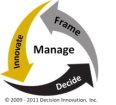The Innovate Step - Generating a robust set of decision alternatives
 In the Innovate step, it is time to identify and/or create decision alternatives. Having completed the Frame step, planning decision making, you should now have a clear set of prioritized success criteria. The objective of the Innovate step is to generate decision options that can meet the needs and desires you have identified during decision framing.
In the Innovate step, it is time to identify and/or create decision alternatives. Having completed the Frame step, planning decision making, you should now have a clear set of prioritized success criteria. The objective of the Innovate step is to generate decision options that can meet the needs and desires you have identified during decision framing.
It is important that multiple alternatives be considered. Potential solutions (decision alternatives) should be adequately described to make them understandable to everyone involved in the decision making process.
Innovating possible new decision options enables you to consider new opportunities and look at a broad range of alternatives, some of which may be outside of your comfort zone. Here are the key pieces of the Innovate step.
Generating decision alternatives - Identifying known solutions

We call this the Innovate step, but it should not be confused with invention. Innovation includes applying known solutions in a new situation, or in some cases, a similar context. Recognize that a number of solutions used in previous decisions may be an innovation for the choice you are trying to make now.
Here are three categories to consider when looking for known decision alternatives:
- Solutions for the same decision made previously - Solutions that have worked in the past may be a good answer for the current decision, particularly if there is no new need or desire motivating change.
- Decision options not pursued for the same decision made previously - Decision alternatives that were considered previously often continue to evolve and improve. When making a decision, previously discarded options may provide the solution needed/desired now. Saving work from the decision making process can make it easier to find these options in the future.
- Solution alternatives for the same decision made for a different situation or context - This category requires considering different situations or environments where a similar decision might be made. For example, finding a parallel decision made in a different industry could provide some innovative solutions for meeting your success criteria.
Generating decision options - Brainstorming innovative alternatives

There are some decisions where a small number of alternative solutions are appropriate, but it is important in the Innovate step to avoid tunnel vision or jumping to a premature conclusion. You can innovate to create new options for most high value decisions. We recommend having 5 to 9 decision alternatives for evaluation during the Decide step.
A number of brainstorming approaches can be used, but here are three that can be used with the known solutions identified above.
- Create hybrids - Identify component parts of known solutions and mix and match parts to create viable new alternatives.
- Gap filling - If known solutions are at opposite ends of a range for satisfying success factors, see if a new option can be created in the gap.
- SWOT analysis - Look at the strengths, weaknesses, opportunities, and threats for known solutions and create innovative alternatives that enhance strengths/opportunities or reduce weaknesses/threats.
How to address having too many decision alternatives
In general, with the overpowering amount of information that is available, in most choices you will find that you are confronted with too many alternative solutions.
For the decision making process to be effective it is important to avoid analysis paralysis that results from having too many options. Everything will slow down as the number of alternatives starts to exceed our ability to mentally keep track of them. More than nine solutions should start raising a warning flag.
Here are some ways to decrease the set of decision alternatives to our suggested number (5 to 9).
- Use key success criteria to quickly remove decision options that are not feasible.
- Identify a higher level choice that can be used to get rid of large blocks of options. Setting a budget is a great example.
- Reframe your decision to narrow its scope. You may need to make a strategy decision to eliminate large numbers of alternative solutions.
- Combine options that have minor differences. You can use decision criteria to find solutions that do not have differences that will be important in the final selection. Combine those options to reduce the analysis in the Decide step.

Return from Decision Alternatives to Decision Making Process
